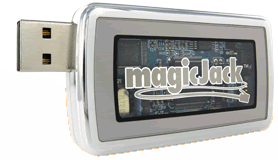Author: Ted Stevenson
Review Date: 11/19/2009

No doubt you’ve heard the old adage “If it sounds too good to be true, it probably is” about a thousand times, right?
Well, what would you say to the idea of a $40 matchbox-size device that connects a standard phone to just about any broadband-connected Windows or Mac computer and gives you a free phone number and cost-free local and long distance North American calling for a year?
Make you think ‘Bernie Madoff’?
Well, it seems there are exceptions to just about every ‘rule.’
The magicJack-available for $39.95 (plus whatever taxes, miscellaneous shipping or other charges apply) directly from magicJack, as well as Radio Shack, Office Depot, BestBuy, and other outlets-does provide a free DID (incoming phone number) and free calling anywhere in the U.S. and Canada for a full year. It also provides voicemail, caller ID, call forwarding, 911 service, and semi-live tech support.
What’s more, it works.
If you buy your magicJack direct from the company, it arrives in a purpose-built 8 ½ x 5 1/4 x 5/8 inch package. In the package are the device itself-which measures about 2 ½ x 1 ½ x slightly under 5/8 inches, and weighs in at just under one ounce (by our old-fashioned postal scale)-a 6-inch USB extension adaptor, and a printed card containing installation instructions (3 pictures and fewer than 20 words), a bit of installation troubleshooting advice, a concise statement of technical requirements (we’ll come back to those in a second), and a detailed set of caveats about the 911 service.
Requirements: magicJack will work for you if-
- You have a Windows XP or Vista PC or an Apple Macintosh.
- You have a high-speed Internet connection (128 kbps or better), such as DSL, cable, Wi-Fi, WiMAX, or FiOS.
Okay, setting up magicJack? Listen VERY carefully. You boot up your computer, if it’s not already running. You plug a phone jack into one end of the matchbox and plug the male USB connector into a powered USB port (preferably on the PC itself-the flexible extension is very handy when you have several USB connections crowded together).
And then you sit around for a few minutes and watch it do its thing. It unpacks software and uploads it to your PC; it establishes connections with the magicJack network (more on that later); it gathers your registration information; it lets you pick an area code just about anywhere; and, finally, it launches the magicJack application, which is also a softphone.
Installation did not proceed automatically when we plugged the device into a USB port on the front of our Windows XP Pro computer, so we followed the troubleshooting advice on the package, unplugged the magicJack, and, after a minute, plugged it into another USB port. Still no install, so after waiting the prescribed two minutes, we used Windows Explorer to locate the magicJack and simply double-clicked the autorun.exe icon. That did the trick.
The software setup took about two minutes, and the entire install took about five, total. Once we had finished selecting an area code and exchange for our DID, the magicJack interface deployed, and we had a complete phone number.
It’s worth saying that if you purchase directly from magicJack, you get free shipping-as well as a 30-day free trial. Just guessing here (since we didn’t actually purchase the device), but that sounds like they don’t bill you until 30 days after you’ve registered your magicJack. So, if you’re a really cautious sort, you can try it out without spending a cent.
The interface has an advertising panel on the left (telling you about even further discounted multi-year service offerings), a telephone keypad surmounted by a browser-style number-entry field, End and Send buttons, and a status panel with three buttons that take you, respectively, to My magicJack, www.weather.com, and Yahoo, using your default browser.
At My magicJack, you can purchase service and/or magicJacks. Service options are five year unlimited calling subscription ($59.95-or $12 per year) and prepaid international calling to India ($0.05 per minute), Argentina, China, and Italy (all $0.02 per minute), and Haiti ($0.24 per minute). Oddly, the $19.95 one-year renewal subscription is nowhere to be seen.
Getting back to the interface, on the right, there is a panel that displays your choice of Contacts, Call History, and Favorites-a list of WWW destinations, which is populated we know not how. Entering contacts is done from the Menu (button above the Contacts panel); they are stored alphabetically.
Below the Contacts panel are buttons for Redial, VMail (dials your magicJack number, whereupon you enter your password and listen to your messages), 411, and Google (takes you to . . . Google.com).
To make calls, you can physically dial your phone (if you’re using a phone), double click a Contact from your list, type the numbers into the number entry panel, or click the keys on the keypad. In our test calling, magicJack placed the call as soon as we finished entering the number, so we’re not sure what the Send and End buttons are for, but no matter.
We used the magicJack to make both local and long distance calls and never had a bad experience. It just worked-with nary a hint of the kinds of problems we’re used to encountering in VoIP calls, such as fade. We did experience brief drop-outs from time to time, but we now know that this is most likely the fault of our jittery DSL connection, not the magicJack service.
Audio quality is limited by your phone, again, if you use a phone. In other words, it will sound like a conventional phone call. Using the softphone with a headset, you’ll get better audio-if you care.
What accounts for this consistent call quality? According to magicJack founder, Dan Borislow, with whom we spoke, it’s due in part to the fact that magicJack-or its parent company, YMAX-owns and manages its own telecommunications network. Moreover, according to Nathan Franzmeier, CEO of sister company Stratus Telecommunications, other arms of YMAX design and make the silicon, produce network infrastructure components, and more. So, it’s largely a self-contained universe-except for the “final mile” to your premises.
As we mentioned in passing, aside from what a generally incredible deal magicJack is, another really cool thing about it is that it is portable.
Traveling? Take the device with you and plug it into a broadband-connected computer. You’ve got more or less instant phone service (it takes a minute or two to download and deploy the software on the unfamiliar PC).
Dan Borislow told VoIPplanet.com that lots of magicJack owners take the device with them when they head off to Europe or other overseas destinations and call back to North America for free. How cool is that?
With conventional phones beginning to dwindle in numbers, you might run into the problem of finding an appropriate computer, with appropriate connectivity, but no appropriate phone. Unfortunately, there’s no way to use your mobile phone with magicJack-yet.
However, the company has promised a wireless femtocell version of the device some time next year that will let you connect using your mobile. Read our coverage here. R
Article courtesy of Enterprise VoIP Planet



